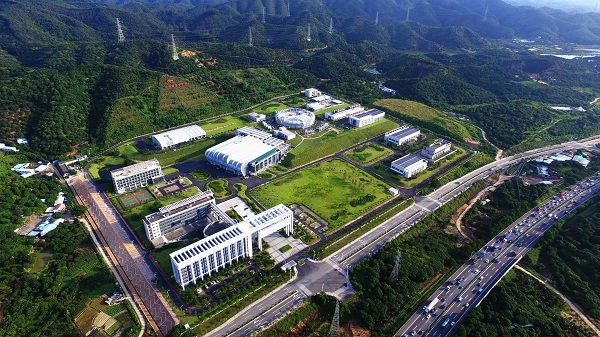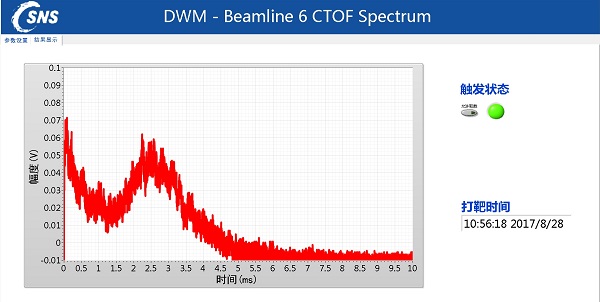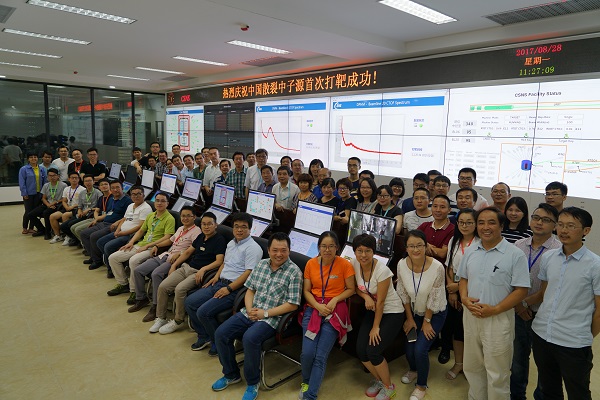 Aerial View of CSNS (Photograghed in July, 2017)
Aerial View of CSNS (Photograghed in July, 2017)
The neutron beam was successfully obtained for the first time at the China Spallation Neutron Source (CSNS) on 28th August. This is a great milestone for the CSNS project, marking the completion of the main construction and entering into the test operation phase. As a national large scientific facility, CSNS has made outstanding achievements, which is considered as a gift to celebrate the coming 19th Communist Party of China (CPC) National Congress during the second half of 2017. According to the schedule, the CSNS project will be fully completed and open to the domestic and international users by 2018.
In the morning on 28th August, the target and instrument control room are occupied by CSNS management teams, scientists, engineers and technicians,looking forward to witness the historic moment. The researchers have carefully prepared for the first production of the neutron beam, while Professor Chen Hesheng, the CSNS project manager gave the order to proceed the 1st official performance test. At 10:56, a proton beam pulse from the accelerator collided on the tungsten target for the first time. Both two neutron detectors at the No.6 and No.20 beam lines, corresponding to two types of moderator, measured the neutron spectrum, which indicates the successful production of the neutron beam.
 The Neutron Spectrum Measured on 28th August, 2017
The Neutron Spectrum Measured on 28th August, 2017
“The idea of building the CSNS in China was first proposed at the Xiangshan Science Conferences in February 2001.” Said Chen Hesheng, and he continued that “The Chinese Academy of Sciences (CAS) gave CSNS a lot of supports since 2006. We worked with more than 100 organizations all over the country, especially in producing equipment for the accelerator, target and instrument systems. We managed to overcome many technical problems and as a result, our equipment localization rate is over 96% and many of them have reached the world-advanced level.”
The CSNS team has spent nearly 6 years on this project and witnesses a lot of significant moments. In October 2011, a groundbreaking ceremony was held. In October 2014, the Hˉ ion source, as the first accelerator equipment, was installed into the linac tunnel. In July 2017, a proton beam was successfully accelerated to 1.6 GeV in rapid cycling synchrotron (RCS). On August 28th, 2017, the neutron beam was obtained.
 Group Photo of the CSNS Team
Group Photo of the CSNS Team
The tungsten target was bombarded with proton beam, which successfully drove neutrons from the nuclei of the target atoms, indicating that the design, fabrication, installation and commissioning of the accelerator and target station systems were finished with high quality and reliability. The achievements made in CSNS marks another glory in the history of Institute of High Energy Physics (IHEP).
As the world's fourth pulsed spallation neutron source, CSNS has a wide range of applications in research areas like materials science, life sciences, physics, chemical industry, new energy and so on. CSNS will serve as a high-level scientific research platform and provide strong supports to help improve the national sustainable development and fulfill the strategic needs of the national security. Also, CSNS will become a large research center in Guangdong Province. “It is for sure that the CSNS, as a world-class comprehensive research base, will make great contributions to the scientific innovation in the Guangdong-Hong Kong-Macao Greater Bay Area.” Said Chen Hesheng in a recent speech.
CSNS is composed of a linac with a modest but upgradable energy of 80 MeV, a rapid cycling synchrotron (RCS) of the energy at 1.6 GeV, 2 beam lines, a target station with a solid tungsten target, and 3 instruments for the first phase including a General-Purpose Powder Diffractometer (GPPD), a Small-Angle Neutron Scattering instrument (SANS) and a multi-purpose reflectometer (MR). The GPPD is used as a tool to study crystal structure and magnetic structure of materials. The SANS is a very important neutron technique useful for probing structures from around 1 nanometer to more than 100 nanometers. It has a wide range of applications from studies of polymers to nanoparticles. The MR is for studying the surface and interface structure of materials through analyzing the reflected neutrons from the sample.



